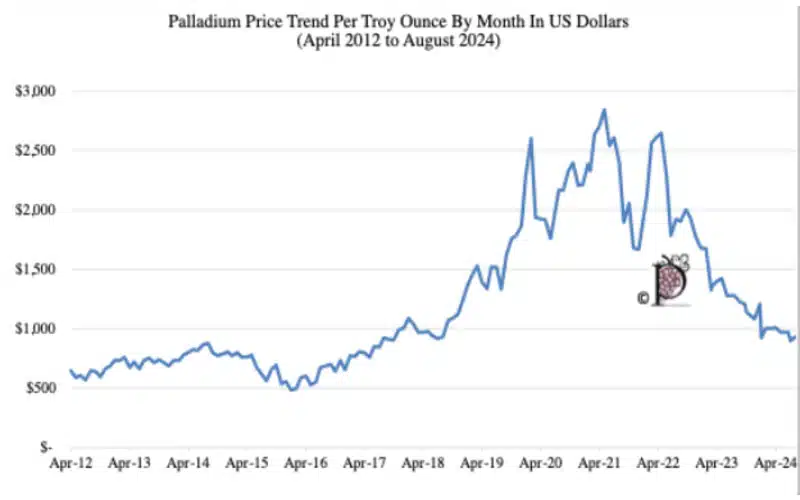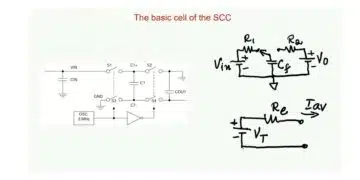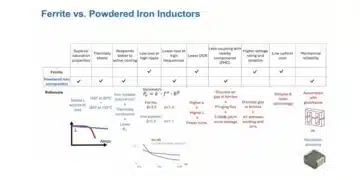This article written by Dennis Zogbi, Paumanok Inc. published by TTI Market Eye provides a price trend overview of key raw materials used for passive electronic components such as nickel, copper, aluminium, zinc, palladium, ruthenium, tantalum and silver.
Passive electronic components are raw material intensive. Raw materials consumed in the production of mass-produced surface mount passive components usually come in the form of engineered powders and pastes. These powders and pastes make up the largest variable cost associated with the production of capacitors and resistors. This is why we have tracked the price and availability of specific ceramics and metals consumed as dielectrics and resistive elements for the past 36 years.
The chart below shows the long-term trend in the variable costs to produce passive electronic components. The trend in September 2024 on a month-to-month basis is in multiple metals products following months of price variations from year’s long global hyper-inflation, choke points in the supply chain and competition amongst industries for critical metals.

The above chart illustrates aggregate pricing for key feedstocks consumed as the primary dielectric material, resistive element, electrode or termination material for the production of trillions of passive electronic components.
How Materials Impact Passive Electronic Component Costs to Produce
Raw materials are the most expensive variable cost associated with the production of passive components. Any fluctuation in price or availability for these key feedstocks can have a negative or positive impact on profit margins. We have demonstrated through deep dive, single client studies that dielectric nano-materials are the single most expensive variable cost to produce for the passive component industry, followed by electrodes, then terminations, then “other” which is comprised of a variety of smaller pieces of technology such as cathode polymers and salt chemistry; alcohol and water chemistry; and cans, stoppers, lead wires, insulation, jacketing, molding, adhesives and tapes.
As Figure 1. illustrates, raw material prices for passive components have declined in October 2023 following a volatile price trend.
The index shown in Figure 1. above is comprised of the following materials:
Nickel
Nickel is the primary electrode material consumed in high capacitance multilayered ceramic chip capacitors (MLCCs). The fluctuations in nickel price are primarily the result of competition for the metal with the steel industry, where it is used as a hardener. Nickel supply is in turn important for the production of X5R, Y5V and X7R MLCCs, which are the capacitors of choice for the operation of smartphones, tablets and TV sets.
The market has shown extreme volatility from 2021 through 2024 due to supply chain choke points, hyper-inflation and competition for keystone metals consumed in multiple industries seeking to reduce carbon emissions. The price of these dielectric, electrode and termination metals, which are key for all energy storage solutions, is expected to continue to react in 2024 and 2025 in direct response to changes in global inflation rates. Expect the price of MLCCs to follow to absorb any small increases or decreases experienced in their nickel electrode paste supply chains.

The chart above illustrates the price trend for nickel ore, which is a keystone material consumed in the multilayered ceramic chip capacitor electrode and a key material for thin film and precision resistive layers.
Copper
Copper engineered powders are consumed in the production of MLCCs as well but as the termination material consumed in conjunction with the nickel type electrode. Therefore, copper and nickel are an important type of base metal duo. Copper is used in some MLCC electrode systems because, unlike its counterpart nickel, it is non-magnetic. The price of this metal, which is key for energy storage solutions, has showed extreme volatility from 2021 through 2024 due to supply chain disruptions.

The chart above illustrates the price trend for copper ore, which is a keystone material consumed in the multilayered ceramic chip capacitor termination matched with nickel electrode and a key specialty electrode material for non-magnetic MLCCs used for example in medical applications.
Aluminum
Etched anode and cathode foils are consumed as the dielectric layers of aluminum electrolytic capacitors. Aluminum comes from bauxite, which is a mined material. Aluminum is abundant in the Earth’s crust and its price has been historically stable. Aluminum electrolytic capacitors are important components consumed in power supplies, television sets, computers and power electronics, including renewable energy systems. The market has shown extreme volatility between 2021 and 2024 due to supply chain problems and speculation due to its substantial sourcing of processing in Eastern Europe.

The chart above shows the price for aluminum ore feedstock, which is a keystone material for aluminum electrolytic capacitor anode and cathode foils as well as a key raw material for resistor substrates.
Zinc
Zinc is used as an additive in ceramic chip capacitors and as the primary ingredient in the production of metal oxide varistors, which are consumed for circuit protection components in all known AC-line voltage equipment and to protect digital electronics from the effects of electrostatic discharge. The zinc price has been more recently unstable as is shown in the chart below.

Zinc is a primary material consumed in non-linear resistor as the active ingredient in zinc-oxide varistors.
Palladium
Palladium is a platinum group metal that is mined in South Africa and Siberia, among other locations. It is consumed primarily for auto-catalysts but also for jewelry and as the primary electrode material is precious metal based MLCCs, which are in turn used in high reliability, high temperature and high voltage printed circuit boards globally. Historically, palladium has proven a difficult raw material partner for the MLCC supply chain because of its price volatility, a by-product of it being a “speculative” metal subject to financial trading and manipulation by institutional investors.

Palladium is a metal that is used in MLCC electrodes for mission critical applications in high voltage, high temperature and high frequency. Such high feedstock pricing impacts costs to produce for many small MLCC manufacturers and this is the primary motivating factor behind the movement to alternative electrodes and alternative MLCC designs in many end-markets where it has not been used before such as fossil fuel engine electronics, defense, space and oil and gas electronics.
Ruthenium
Ruthenium is a precious metal that is similar to that of palladium, but its primary purpose is to be consumed in all thick film chip resistors and resistor networks produced worldwide. The price of ruthenium has shown extreme volatility because of its association with palladium mining activities in South Africa. The reader should remember that reliance on ruthenium for all mass-produced thick film chips is a weakness that threatens the entire high-tech economy.

This price volatility has caused customers to seek alternative resistor designs also based upon thin film nickel. Unfortunately, the economies of scale of manufacturing for thin film resistors are but a small fraction of that of thick film chips, one of the largest volume products produced in the world (measured in the trillions of pieces). Resistors represent a significant volume of worldwide consumption for ruthenium metal (with additional uses as a cracking catalyst, a hard disc drive coating and as an esoteric chemical compound). Therefore, the metal is very sensitive to any changes in resistor supply and demand the global high tech economy and its signpost on the current market conditions should not be overlooked by the precious metal market analyst.
Tantalum
The majority of tantalite metal used in the production of tantalum capacitors comes from Central Africa. Other known tantalite resources are located in Australia, Brazil and Canada. Tantalite’s primary use is as capacitor grade tantalum metal powder for consumption in capacitor anodes. Tantalum capacitors are consumed in communications networking equipment, smartphones, automotive, medical and defense electronics. Tantalite and tantalum ores have demonstrated volatile pricing in the past but has remained relatively stable in price during the current market shortages. The reader should know that the lessons learned from the tantalum supply chain have been and will continue to be valuable as OEM brands insist on transparency on all material supply chains. Tantalum pricing has been stable in comparison to other dielectric materials for an extended period of time.

Paumanok Publications estimates that the primary raw materials consumed in the production of tantalum capacitors are capacitor grade tantalum metal powder and wire, which is engineered from high purity tantalum ores and concentrates. Tantalum, a rare metal, represents a significant portion of the variable costs to produce for tantalum type capacitors.
Silver
Silver is consumed as a termination material for many electronic components but primarily for MLCCs that employ precious metal electrodes. MLCCs with precious metal electrodes and silver terminations are in turn consumed in high voltage, high temperature and high reliability MLCCs for similar end-use market segments.

Summary: Electronic Materials Markets and Outlook For 2024
Raw materials impact the overall costs to produce passive electronic components. In fact, dielectric materials, electrode materials and termination materials represent the largest variable cost associated with the production of electronic components. Any fluctuation in price or availability for these key feedstocks can have a negative impact on profit margins for electronic component producers.
This article illustrates how pricing for raw material feedstocks consumed in the production of passive components have experienced new price highs over the past four years in direct response to global inflation and significant strength of the U.S. dollar to other key currencies in the matric, primarily the yen, the won and the NT$. As we enter the fourth quarter of CY 2024 at time of writing this article, we note that copper, silver and ruthenium remain at elevated prices compared to pre-pandemic market conditions. Aluminum, nickel and zinc pricing have stabilized while palladium and tantalum prices have come down substantially.
The vertical integration of key price parameters further up the supply chain show elevated prices remaining for termination metals for mass produced components such as capacitors and resistors. However, price stability is expected in electrode materials and dielectrics, with some costs to produce for specialty components coming down in reflection of declining palladium and tantalum prices.


































